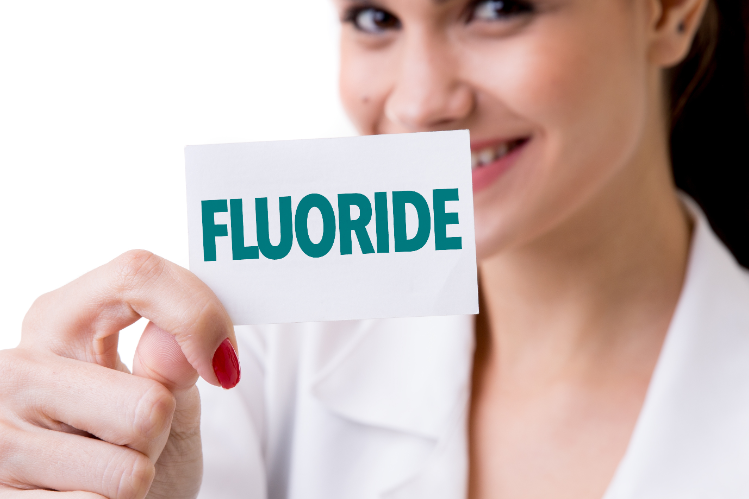
El flúor es una palabra de moda hoy en día. No solo aparece en la pasta de dientes y es recomendado por los dentistas, sino que... También se está volviendo muy popular en el mundo de las redes sociales. Sin embargo, en medio de muchos hechos, también hay... Existe mucha desinformación. ¿Qué es el flúor? ¿Cómo se usa?
El flúor para los dientes es básicamente el héroe anónimo del cuidado dental. No hace que tus dientes brillen ni te da ese brillo. El brillo de una estrella de cine, pero silenciosamente hace algo mucho más importante: ayuda a prevenir las caries incluso antes de que aparezcan. comenzar.
Analicemos cómo protege el flúor , por qué los dentistas confían en él y cuándo. Tal vez valga la pena prestar un poco más de atención a lo que estás recibiendo.
¿Qué es el fluoruro?
El flúor es un mineral natural que se encuentra en el agua, la tierra e incluso en ciertos alimentos. No es una sustancia química sofisticada que le receta el dentista. inventado - ha existido desde siempre.
Cuando se trata de los dientes, la función principal del flúor es bastante simple: fortalece el esmalte y lo hace más resistente. contra todos esos ataques de ácido que ocurren cada vez que comes o bebes algo azucarado o picante, porque cuando Esas bacterias en la boca comienzan a producir ácido que desgasta lentamente el esmalte, el flúor entra en acción y ayuda a contraatacar, manteniendo las cosas fuertes y protegidas.
Lo encontrarás en cosas cotidianas: pasta de dientes, enjuague bucal e incluso en el agua del grifo. Y cuando tu dentista habla de " tratamiento con flúor ”, simplemente le están dando a tus dientes un impulso adicional de ese mineral protector.
¿Qué hace el flúor?
Entonces, ¿qué hace realmente el flúor? En resumen, fortalece los dientes y previene la formación de caries. Pero Así es como funciona:
- Remineraliza el esmalte: cuando el ácido comienza a dañar el esmalte, el flúor interviene y Ayuda a reconstruirlo. Piensa en ello como reparar pequeñas grietas antes de que se agranden.
- Fortalece los dientes: con el tiempo, el flúor se absorbe en el esmalte, haciéndolo más resistente. contra la decadencia.
- Protege los dientes en desarrollo de los niños: En el caso de los niños, el flúor ayuda a desarrollar dientes más fuertes incluso antes de que lleguen por completo.
- Combate la caries prematura: En las primeras etapas de la caries causada por la placa dental , el flúor puede revertir el daño. Sí, puede. Deshacer parte del daño antes de que se convierta en una caries.
Es un gran ejemplo que demuestra que la prevención realmente funciona mejor que la cura.

Tratamientos con flúor en el dentista
Si alguna vez su dentista le ha aplicado algún gel o algo parecido a una pintura al final de su cita, eso fue... flúor. Es básicamente un refuerzo rápido para tus dientes, especialmente si tienes caries con facilidad o si tu esmalte está dañado. Ha visto mejores días. No hay un proceso complicado. El dentista simplemente aplica un gel o espuma de flúor concentrado. barniz, lo dejas reposar un rato y listo.
Solo toma unos minutos. Después, generalmente le indicarán que no coma ni beba durante aproximadamente media hora. Solo para darle Es hora de sumergirse y hacer su trabajo.
El tratamiento con flúor por parte del dentista es común tanto para niños como para adultos, especialmente si:
- Te salen caries con facilidad
- Tienes dientes sensibles
- ¿Usas aparatos ortopédicos o alineadores?
- Bebes agua embotellada o filtrada (que podría eliminar el flúor natural)
Piense en ello como una capa protectora para sus dientes: invisible, indolora y efectiva.
¿El flúor es bueno o malo para los dientes?
Bien, aquí está la gran pregunta: ¿el flúor es bueno para los dientes o no?
Respuesta corta: sí, es bueno, en la cantidad adecuada.
El flúor es, de hecho, una de las principales razones por las que no vemos tantas caries hoy en día. Cuando se usa correctamente, Es seguro, está bien investigado y es muy bueno para mantener el esmalte fuerte. Por eso la mayoría de los dentistas lo mantienen. Recomendar pasta dental con flúor - y por qué el agua del grifo en gran parte de los EE.UU. ya tiene un poco del mismo añadido.
La cuestión es que el flúor es excelente, pero demasiado puede ser contraproducente. No es algo que los adultos necesiten realmente. de qué preocuparse, pero para los niños, es una historia diferente. Cuando sus dientes aún se están formando debajo de las encías, Más flúor del que realmente necesitan puede afectar el desarrollo del esmalte.
No duele ni causa caries ni nada grave, pero puede dejar pequeñas manchas blancas o parches nublados en la piel. superficie una vez que salen los dientes. Eso es lo que los dentistas llaman fluorosis. Es inofensiva, pero no es ideal. Si buscas unos dientes con un aspecto perfectamente uniforme.
En los adultos, es extremadamente raro consumir demasiado flúor, a menos que se ingiera pasta de dientes o se tomen dosis altas. Suplementos que no necesitas. Entonces, ¿el flúor es malo para los dientes? Para nada, a menos que lo uses en exceso. Usado correctamente es una de las mejores defensas que puede tener tu sonrisa.
Posibles efectos secundarios del flúor
El flúor es seguro cuando se usa según las indicaciones, pero hay que tener en cuenta lo siguiente:
- Fluorosis leve (en niños): rayas blancas o manchas tenues en los dientes, generalmente por tragar. Demasiada pasta de dientes mientras los dientes aún se están formando.
- Malestar estomacal: poco común, pero tragar grandes cantidades de flúor a la vez (como comer un Un montón de pasta de dientes puede causar náuseas.
- Reacciones alérgicas: Extremadamente poco comunes, pero algunas personas pueden experimentar una irritación leve.
¿La buena noticia? Estos efectos secundarios se evitan fácilmente siguiendo hábitos sencillos: use una cantidad del tamaño de un guisante pasta de dientes, supervise a los niños mientras se cepillan y no se enjuague demasiado después del cepillado: deje que el flúor actúe. Esmalte por un rato.
Consejos cotidianos para aprovechar al máximo el flúor
Si quieres fortalecer tus dientes con flúor, no se trata de hacer nada sofisticado. Se trata de pequeños pasos. Hábitos constantes que se desarrollan con el tiempo. Aquí te explicamos cómo sacarles el máximo provecho:
Cepíllese los dientes dos veces al día con pasta dental con flúor.
Esta es simple pero poderosa. La pasta dental con flúor le da a tu esmalte una pequeña dosis de protección cada vez que... Cepíllate. Intenta no enjuagarte la boca inmediatamente después; simplemente escupe el exceso. Deja que el flúor permanezca en tu boca. dientes un poco más largos para hacer su trabajo.
Beber agua del grifo: en serio, es la forma más fácil de ganar.
La mayoría del agua del grifo en Estados Unidos ya contiene flúor en niveles seguros y efectivos, lo que significa que está protegiendo su salud. dientes todos los días sin siquiera intentarlo. Sin embargo, si solo bebe agua embotellada o muy filtrada, es posible que En realidad, podríamos estar perdiéndonos ese beneficio sin darnos cuenta.
Utilice un enjuague bucal con flúor, pero sólo si su dentista lo aprueba.
Un enjuague bucal rápido con flúor puede ser útil si eres propenso a las caries o tienes dientes sensibles. Solo recuerda: No lo uses inmediatamente después de cepillarte los dientes. Espera unos 30 minutos para no eliminar todos los beneficios de tu pasta dentífrica.
Reciba un tratamiento profesional con flúor de vez en cuando.
Su dentista puede aplicar un gel o barniz de flúor mucho más concentrado que cualquier otro que use en casa. Esto proporciona Para darle a su esmalte un impulso adecuado, es especialmente útil si sus dientes están un poco débiles, ha tenido algunos empastes o Sólo quiero esa capa extra de protección.
No te excedas.
Más flúor no significa dientes más fuertes. Usar demasiados productos a la vez o tragar pasta de dientes puede... Causar problemas, especialmente en los niños. Siga las recomendaciones de su dentista; con eso es más que suficiente.
Al final, la constancia es lo que gana. Pequeñas cantidades de flúor, utilizadas adecuadamente todos los días, hacen mucho más por... tus dientes que tratamientos puntuales o productos caros. Son los pequeños hábitos diarios los que mantienen tu esmalte. Fuerte para el largo plazo.
El fluoruro explicado de forma sencilla
Al final, el flúor para los dientes no es complicado. Es una de esas cosas que simplemente cumple su función sin hacer mucho ruido. - fortalecer el esmalte, combatir la caries y mantener los dientes sanos.
Claro, demasiado puede causar problemas, pero para la mayoría de las personas, el cepillado regular y un tratamiento con flúor ocasional al final de la jornada son suficientes. Los tratamientos dentales son perfectamente seguros e increíblemente efectivos.
Entonces, si alguna vez te has preguntado "¿es bueno el flúor para los dientes?" , la respuesta es un rotundo sí. Es uno de los... Las formas más sencillas de fortalecer tus dientes y mantener tu sonrisa protegida durante años.
Preguntas frecuentes
1. ¿El tratamiento con flúor es bueno para los dientes?
Sí, el flúor ayuda a fortalecer el esmalte, haciéndolo más resistente al ácido y caries. Es como un escudo para tus dientes, ayudando a detener los primeros signos de caries antes de que Incluso empiezan.
2. ¿Por qué los dentistas ya no realizan tratamientos con flúor?
Todavía lo hacen, pero no para todos. La mayoría de los adultos que usan flúor... La pasta de dientes y el agua fluorada ya son suficientes. Los dentistas suelen recomendar Tratamientos con flúor para personas que sufren caries frecuentes, tienen dientes sensibles o tienen esmalte más débil.
3. ¿Cuánto cuesta un tratamiento con flúor?
En los EE. UU., los tratamientos profesionales con flúor suelen costar entre $20 y $50. Dependiendo de la clínica y de dónde vivas. También puede estar incluido como parte de tu Revisión periódica y limpieza.
4. ¿Cuál es la desventaja de utilizar flúor?
El único problema real proviene del exceso de flúor. El uso excesivo (especialmente en niños) puede causar leves manchas blancas en los dientes llamadas fluorosis. Pero en niveles normales, como en pasta de dientes o en agua del grifo: es completamente seguro.
5. ¿Vale la pena pagar por el flúor en el dentista?
Definitivamente, especialmente si eres propenso a las caries o tienes desgaste del esmalte. El barniz de flúor aplicado por el dentista es más fuerte que el que se encuentra en la pasta de dientes y ofrece Protección adicional durante meses.
6. ¿Cuánto dura un tratamiento con flúor?
Por lo general, entre 3 y 6 meses. Por eso, la mayoría de los dentistas lo aplican durante... Revisiones regulares dos veces al año.
7. ¿Por qué no comprar flúor en el dentista?
Si sus dientes están sanos y usa pasta dental con flúor a diario, es posible que... No necesitas una dosis extra. Pero si tu esmalte está más débil o te has sometido a un tratamiento dental reciente, Ese flúor adicional puede marcar una verdadera diferencia.
8. ¿Cuánto tiempo hay que esperar para comer después de un tratamiento con flúor?
Generalmente unos 30 minutos. Eso le da tiempo al flúor para absorberse. esmalte y hacer su trabajo correctamente.
9. ¿Los dentistas cobran por el tratamiento con flúor?
Algunos lo incluyen en tu visita de limpieza, otros lo cobran aparte. Pregunta siempre. Primero: es un pequeño costo para un gran beneficio.
10. ¿Con qué frecuencia debo recibir tratamiento con flúor en mi dentista?
A la mayoría de las personas les va bien con dos tratamientos al año, pero su dentista podría... Sugiera más si tiene un mayor riesgo de caries.
11. ¿Cómo eliminar la caries dental uno mismo?
Lamentablemente, no se puede. Una vez que se forma una caries, es necesario que un dentista la trate. Lo que puedes hacer es evitar que el daño prematuro del esmalte empeore: cepillarte con usar pasta dental con flúor, reducir el azúcar y acudir a los controles médicos.
12. ¿El tratamiento con flúor es doloroso?
Para nada. Es rápido, sencillo y completamente indoloro; generalmente se cepilla o... pintado sobre los dientes y dejado reposar durante unos minutos.
Citas:
“Beneficios del flúor”. Estado: NY - Nueva York, 2025, www.nysdental.org/for-the-public/benefits-of-fluoride.
Asociación Dental Americana. “Fluoruro: Suplementos tópicos y sistémicos”. www.ada.org, 14 de junio de 2023. www.ada.org/resources/ada-library/oral-health-topics/fluoruro-topico-y-sistemico-suplementos.






